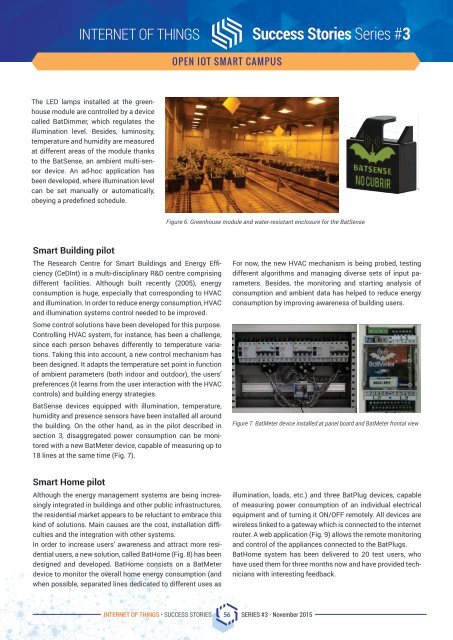Success Stories
VEZSJ
VEZSJ
Create successful ePaper yourself
Turn your PDF publications into a flip-book with our unique Google optimized e-Paper software.
Internet of Things <strong>Success</strong> <strong>Stories</strong> Series #3<br />
Open IoT Smart Campus<br />
The LED lamps installed at the greenhouse<br />
module are controlled by a device<br />
called BatDimmer, which regulates the<br />
illumination level. Besides, luminosity,<br />
temperature and humidity are measured<br />
at different areas of the module thanks<br />
to the BatSense, an ambient multi-sensor<br />
device. An ad-hoc application has<br />
been developed, where illumination level<br />
can be set manually or automatically,<br />
obeying a predefined schedule.<br />
Figure 6. Greenhouse module and water-resistant enclosure for the BatSense<br />
Smart Building pilot<br />
The Research Centre for Smart Buildings and Energy Efficiency<br />
(CeDInt) is a multi-disciplinary R&D centre comprising<br />
different facilities. Although built recently (2005), energy<br />
consumption is huge, especially that corresponding to HVAC<br />
and illumination. In order to reduce energy consumption, HVAC<br />
and illumination systems control needed to be improved.<br />
Some control solutions have been developed for this purpose.<br />
Controlling HVAC system, for instance, has been a challenge,<br />
since each person behaves differently to temperature variations.<br />
Taking this into account, a new control mechanism has<br />
been designed. It adapts the temperature set point in function<br />
of ambient parameters (both indoor and outdoor), the users’<br />
preferences (it learns from the user interaction with the HVAC<br />
controls) and building energy strategies.<br />
BatSense devices equipped with illumination, temperature,<br />
humidity and presence sensors have been installed all around<br />
the building. On the other hand, as in the pilot described in<br />
section 3, disaggregated power consumption can be monitored<br />
with a new BatMeter device, capable of measuring up to<br />
18 lines at the same time (Fig. 7).<br />
For now, the new HVAC mechanism is being probed, testing<br />
different algorithms and managing diverse sets of input parameters.<br />
Besides, the monitoring and starting analysis of<br />
consumption and ambient data has helped to reduce energy<br />
consumption by improving awareness of building users.<br />
Figure 7. BatMeter device installed at panel board and BatMeter frontal view<br />
Smart Home pilot<br />
Although the energy management systems are being increasingly<br />
integrated in buildings and other public infrastructures,<br />
the residential market appears to be reluctant to embrace this<br />
kind of solutions. Main causes are the cost, installation difficulties<br />
and the integration with other systems.<br />
In order to increase users’ awareness and attract more residential<br />
users, a new solution, called BatHome (Fig. 8) has been<br />
designed and developed. BatHome consists on a BatMeter<br />
device to monitor the overall home energy consumption (and<br />
when possible, separated lines dedicated to different uses as<br />
illumination, loads, etc.) and three BatPlug devices, capable<br />
of measuring power consumption of an individual electrical<br />
equipment and of turning it ON/OFF remotely. All devices are<br />
wireless linked to a gateway which is connected to the internet<br />
router. A web application (Fig. 9) allows the remote monitoring<br />
and control of the appliances connected to the BatPlugs.<br />
BatHome system has been delivered to 20 test users, who<br />
have used them for three months now and have provided technicians<br />
with interesting feedback.<br />
Internet of Things • <strong>Success</strong> <strong>Stories</strong> 56 SERIES #3 - November 2015









